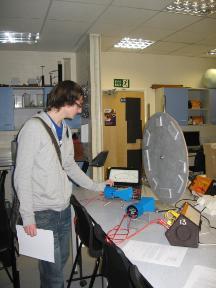The Sound of Music (MUS)
This chapter approaches the physics through the study of music and recorded sound, focusing on the production of sound by musical instruments and the operation of a compact disc (CD)or DVD player.

The chapter asks and answers such questions as 'What factors affect the note produced by a guitar?', 'What size do the bumps on a CD or DVD need to be?' and 'Why does a CD/DVD player need a laser source?'.Its main elements are (i) travelling and standing waves, (ii) how reflection, refraction and superposition come into play in reading information from a CD, (iii) explaining the behaviour of light through wave and photon models, and (iv) looking at atomic line spectra in terms of transitions between discrete energy levels.
The photograph shows a model CD that can be ‘read’ using 3 cm microwaves.
The chapter makes considerable use of software (such as the free download Audacity) which allows students to analyse and synthesise sounds.
The main physics content areas are:
- Travelling and standing waves
- Photons and atomic energy levels
